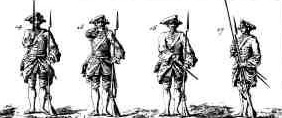
LCFMarine
Website Design and Content © 2004 by Eric
Krause, Krause House Info-Research Solutions (© 1996)
All Images ©
Parks Canada Unless Otherwise Designated
Researching the
Fortress of Louisbourg National Historic Site of Canada
Recherche sur la Forteresse-de-Louisbourg Lieu historique national du Canada
Compagnies Franches De La Marine Site

COMPAGNIES FRANCHES DE LA MARINE IN LOUISBOURG IN 1745
Introduction
From the time of its founding in 1713 until the New England-led siege of 1745 the French colonial town of Louisbourg was garrisoned by soldiers of the Compagnies franches de la marine, Karrer Regiment and Canonniers-Bombardiers.
In the period between 1749 and 1758 the French garrison included Compagnies franches de la marine, Cannoneers, and the Artois, Bourgogne, Cambis and Volontaire Etrangeres regiments.
The citizens of Louisbourg were called out prior to the siege of 1745 to form a militia.
The Compagnies franches de la marine
The Compagnies franches de la Marine, independent companies of the Navy Department, formed the nucleus of the Louisbourg garrison.
The governor or commandant at Louisburg was the highest ranking officer and commanded the garrison. Second in command was the king's lieutenant (lieutenant de roi). The day to day administration of the garrison was carried out by town major and his staff. The staff included an adjutant (aide-major) and one or two assistants (garçons-major).
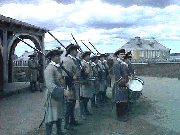 The Compagnies franches was not organized into regiments. Each company
belonged to and was the responsibility of a captain who administered its affairs. The
officers of a company consisted of the captain, a lieutenant, an ensign and a sub-ensign.
There were 2 sergeants, 2 corporals, 2 drummers and between 45 and 65 men.
The Compagnies franches was not organized into regiments. Each company
belonged to and was the responsibility of a captain who administered its affairs. The
officers of a company consisted of the captain, a lieutenant, an ensign and a sub-ensign.
There were 2 sergeants, 2 corporals, 2 drummers and between 45 and 65 men.
In addition to garrisoning, Louisbourg the Compagnies franches soldiers were distributed amongst other posts of the Isle Royale colony including:
Port Toulouse ( St. Peters) - 25 men, 2 officers
Port Dauphin ( Englishtown) - 7/8 men and
Isle Saint-Jean ( Prince Edward Island ) - 40 men and 2 or 3 officers
At Louisbourg in addition to the town, a company was stationed at the Royal Battery on the north shore of Louisbourg harbour and a small detachment was posted on the Island Battery in the mouth of the Harbour.
The Isle Royalle Garrison in 1743 consisted of approximately 700 troops. If you subtract the cannoneers (30) and the Swiss ( Karrer Regiment - 143 ) it would leave a total of 527 Compagnies franches. Subtracting the Isle St. Jean and outport garrisons would reduce that total to 448 Compagnies franches stationed in Louisbourg.
Louisbourg fortress garrison in 1745
Compagnies franches de la Marine - 448
Compagnie de Canoniers-Bombardiers - 30
Karrer Regiment - 143
Recruitment
The captain of a company was responsible for recruitment. Because of the distance between the Isle Royalle colony and France recruitment for Louisbourg was done by professinal recruiters in France. Only when the garrison was expanded in 1730 did two newly-appointed captains, de Gannes and d'Ailleboust, go to France to find men.
Enlistment was voluntary in theory though trickery was not uncommon. A new recruit received an enlistment bounty and signed a contract. The minimum term of engagement was 6 years (engagement limité) though the military establishment preferred an unlimited term of enlistment ( engagement perpetuel).
Most of the recruiting for the colonies was done in Paris, though
recruits could be young men who had come to Paris from the provinces.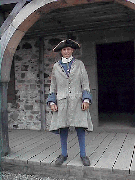
All soldiers were supposed to be 16 years or older, 5 pieds 1 pouce in height, and physically fit to serve. This was particularly important for Isle Royale where the men worked on the construction of the fortifications. There was an instance in 1732 when 10 men with gall-bladder ailments were taken from a ship set to sail for Louisbourg and transferred to one which took them to the garrison in Louisiana. However, recruiters were lax about a strict adherence to the regulations and there were some soldiers below the minimum height and probably many who were younger than the basic 16 years. In 1726 the majority of the 40 recruits for that year were between 15 and 16 years old.
Men would join the garrison for any number of reasons. Perhaps the most significant reason was employment, to keep from starving. Others joined to escape the law, and at least 3 came to Louisbourg through letters de cachets.
Discharge
It was policy to keep discharges to the absolute minimum. The government did not want to loose the investment in training and equipping the soldiers of the Compagnies franches. Most of those sent back to France on a regular basis were invalids, hurt during the construction of the fortifications. In 1725 there had been an ordinance issued instructing the governor to discharge one man from each Compagnies franches company as well as 2 catholic Swiss each year on the condition they would settle on the island. They would receive 3 years pay and food. There was no action taken on this until the 1750s and even then there were never a great number of soldiers who chose to settle on the land. There are examples of discharges being given to men whose families requested it and could provide 150 livres. There are 24 instances of this type of discharge in Louisbourg between 1722 and 1741. However there was never any systematic programme of discharge and none after 1743 with the threat of war between France and England.
Food
Just how well did an 18th century Compagnies franches soldier fare when it came to the food he was allocated by the government?
Depending on the year we are talking about the soldier received 1 ½ livres of bread ( 1718), 1 ¼ livres of flour ( 1734 ) or 1 livre of bread ( 1742 ). In addition there was 4 oz of pork or 8 oz of beef, 4 oz of vegetables (beans mostly), 1/2 oz of butter and 2.6 oz of molasses a day. The mollases ration could possibly have been used for spruce beer.
Using a modern calorie counter it is estimated that the daily caloric intake for a soldier eating government rations would be between 1940 and 2240 calories. Let's round this off to 2100 calories.
I have assumed that a representative soldier would weigh 150 pounds. Given an active day of guard duty, work in a garden or hauling wood, the soldier would need about 2550 calories. Given a strenuous day, working as a labourer on the construction of the fortress the soldier would need about 3000 calories.
With an approximate intake of 2100 calories from government rations an active soldier on sentry duty would be 450 calories short and a soldier working a strenuous day on the construction would be 900 calories short of the energy needed to keep him going.
We have no idea if a soldier ate all his rations. Nor do we know to what extent he used the extra money he made working on the construction of the fortifications or on other work to buy food to supplement his rations. We know that some soldiers hunted, ( they were expected to augment their rations and given a gun powder allowance to do so ) but it is impossible to factor this into the daily caloric intake.
We know that an average soldier would drink - encouraged by the lifestyle and the captains' canteens but we don't know the daily consumption.
Food was prepared communally in the barracks. There was one large pot issued for every 7 or 8 men along with spoons.
Living Conditions
The Compagnies franches soldiers lived in the Barracks located in the
Kings Bastion. One half of the large structure was taken up by the apartment of the
governor, by officers rooms and the garrison chapel. The other half provided rooms for the
soldiers. They slept two to a bunk with 12 to 16 men in a room. Straw ticks and woolen
blankets were provided.
The barracks was in deplorable condition. Governor Duquesnel suggested the construction of a new barracks in 1740, since the citadel barracks was infested with vermin and was slowly rotting away. A year earlier the previous Governor, de Forant , had complained about the quality of the Louisbourg troops saying that he would not keep 100 of them. But he complained as well of the living conditions of the men saying that they were lacking sheets and mattresses. He wrote:
Allow us to impress upon you, my lord, the need for a supply of mattresses and sheets for the soldiers. The country is harsh enough to require such materials and it is impossible for them to keep clean the uniforms in which they sleep in winter; moreover, the straw on which they sleep is changed only once a year, and this results in so many insects in their quarters that the majority prefer to sleep on the ramparts during the summer.
Pay
On the books a soldier received 9 livres per month. However most was deducted in France for uniforms and food. This resulted in only 1 ½ livres being sent to the colony. Out of this 18 livre annual salary an additional 3 was deducted for the surgeon's assistant. Since the company captain received the remaining 15 livres to ensure debts to him were covered it is doubtful if any money actually made it to a soldier's pocket.
Fortunately a soldier could earn extra money working on the fortifications, or working for the civilian inhabitants of the town. Even those soldiers who remained on guard duty earned between 27 and 30 livres a year from a fund that was deducted from the wages of the soldiers who could work on construction.
We don't know how many soldiers would regularly work for the civilian contractor who was building the fortress, but in 1724 there were 236 of the 430 soldiers in the garrison employed on the walls between May and October.
Even with this potential source of income the common soldier was at the mercy of his superiors. In the 1720s while wages were paid directly to the soldier there were many occasions when the wages were not available. The civilian contractor gave instead notes that could be redeemed for goods.
As well, the company captains had monopoly on sales to the soldiers who were supposed to purchase all extra goods such as shoes, stocking, tobacco and even liquor from the captain's canteen.
By the 1730s the company captains had convinced the contractors to pay the soldiers wage directly to them. With this accomplished the soldier was virtually trapped by the system of officer-run canteens. There were complaints to be sure. In 1740 Governor Duquesnel wrote that the solider workers generally received no money. The abuses reached the notice of the Minister of Marine who suspended awarding the Croix de St-Louis in 1742. However his concerns about the abuses and efforts by Governors de Forant and Duquesnel to curb the abuses of the canteen system failed.
Uniform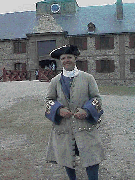
The Compagnies franches soldier wore a grey-white woollen greatcoat (justaucorps), lined with blue and closed by brass or copper buttons. He had a blue wool vest, breeches and stockings. His linen consisted of a shirt and a cravate. On his feet he wore leather shoes and on his head a black tricorne with false gold braid, a black cockade and a brass or copper button.
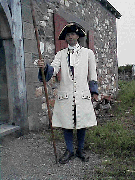 Clothing was issued on a two year cycle. The first issue was the
"full dress" consisting of justaucorps, 1 pair of breeches, 2 shirts, 2
cravates, a hat, 1 pair of stockings and 2 pair of shoes. The second year issue or
"small dress" consisted of a waistcoat, breeches, 2 shirts, 2 cravates, a hat, 1
pair of stockings and 2 pairs of shoes.
Clothing was issued on a two year cycle. The first issue was the
"full dress" consisting of justaucorps, 1 pair of breeches, 2 shirts, 2
cravates, a hat, 1 pair of stockings and 2 pair of shoes. The second year issue or
"small dress" consisted of a waistcoat, breeches, 2 shirts, 2 cravates, a hat, 1
pair of stockings and 2 pairs of shoes.
Officers uniforms were not supplied by the Marine ministry. As late as 1757 Montcalm was insisting on the necessity of providing a distinct uniform for officers serving in New France.
The Mutiny of 1744
On the day after Christmas, 1744, the Louisbourg garrison mutinied. The actual event lasted for only an hour or two.
In 1744 France and England were at war. Louisbourg had taken a proactive part in these events by attacking the English garrison at Canso and issuing letters of marque to privateers. By the late summer of 1744 there were several hundred New Englanders in Louisbourg, requiring support from the government storehouse. Late in the summer ships of the French East India company gathered at Louisbourg, rerouted there after news of a possible attack by English ships in the English Channel. The need to resupply the East India Company ships for the trip across the Atlantic put another burden on the colony's fragile food supply. In late 1744, Francois Bigot, the Civil Administrator of the colony, sold food from the King's storehouse to civilians. The soldiers, who were still on full rations, received inferior provisions.
The vegetables distributed the week before Christmas were rotten and inedible. Some of the soldiers who ate them became ill. Members of the Karrer Regiment attempted to return the vegetables but were turned away by the storekeeper. They brought their complaints to their commanding officer, but were not given a hearing. Several days before Christmas the few Karrer soldiers who were the leading agitators drew up a petition to give to the acting governor. Plans were made for a peaceful gathering of the garrison to protest their situation. The Karrer visited the Compagnies franches barracks to elicit help. On the morning of December 27 the Karrer detachment assembled under arms in the place d'armes of the King's Bastion. Ensign Rasser arrived to meet this group and hear their complaints. These complaints included receiving rotten vegetables, having to work for private individuals and officers, and a request for compensation for their part in the successful raid on Canso. Rasser promised to carry the message and then ordered the men to their barracks. While he was away talking to his commanding officer, the Karrer reproached the French for not joining in the demonstration. The French reacted to this by coming out in force. Their drummers, protected by a guard with fixed bayonets, marched through the town. The Compagnies franches officers arriving at the barracks were threatened with physical harm. There was talk of killing all the officers and burning the town. So in control of the town was the garrison that the acting commandant, Duchambon, surrendered to the demands of the troops. These demands differed from those expressed by the Karrer, but reflected the frustration of the soldiers. The demands included an increase in the issue of firewood and the return of 5 cords that had been confiscated by officers, the issue of rations that the soldiers were not given while away at Canso, and the reimbursement of a clothing deduction to 100 of the recruits of 1741 who had never received their uniforms.
The entire event was over in several hours, though for the next few months life in the garrison was tense. On the eve of the siege in 1745, Duchambon gathered the garrison and asked that they put the past behind them to fight against the New Englanders. The soldiers asked that a complete pardon be given to those involved in the mutiny and Duchambon agreed with the request. The only remnant of discontent was during the siege when the soldiers were required to work repairing the damage caused by New England cannon, they would only work for double the regular pay. The Compagnies franches soldiers fought well during the siege. After the successful New Englanders took over the town the garrison and civilian population was returned to France. At Rochefort 159 men deserted and many died in the hospital there. In spite of the pardon promised by Duchambon those who had taken an active part in encouraging the mutiny were tried. Three from the Karrer Regiment and 5 from the Compagnies franches were executed.